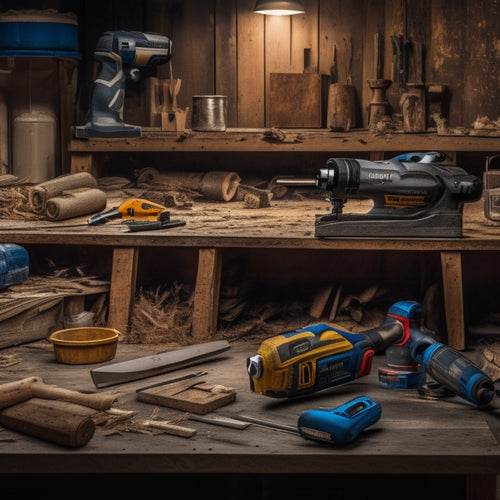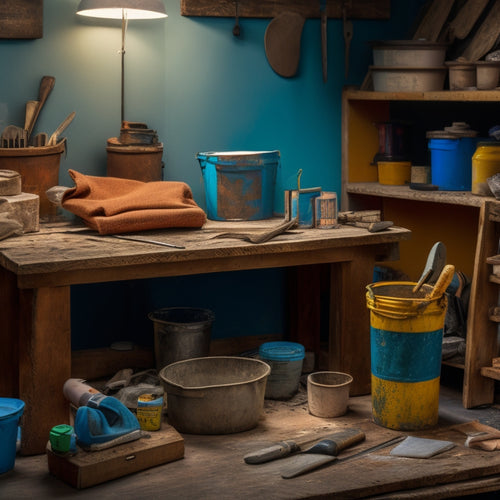
Streamlined Block Wall Tool Kits for Renovation
Share
You're about to revolutionize your block wall renovation projects with streamlined tool kits that can save you up to 50% in labor costs and minimize material waste. Essential tools like trowels, levels, and hammers guarantee strong block bonds and accurate alignments. Simplify installation with organized tools, material prep, and beginner tips. Efficient mortar mixing solutions and precision leveling techniques further optimize the process. To take your project to the next level, explore advanced tools like block saws, grinders, and precision leveling systems. As you discover more about these tools and techniques, you'll reveal the secrets to faster, stronger, and more cost-effective block wall renovations.
Key Takeaways
• Essential tools for block walls include trowels, levels, hammers, mixing buckets, and finishing tools to ensure strong block bonds and aesthetics.
• Organizing tools into categories and preparing materials in advance simplifies the installation process and reduces project timelines.
• Efficient mortar mixing solutions involve optimizing mix design, selecting compatible materials, and using additives to enhance performance and durability.
• Automated material handling systems with precision measurement and quality control measures minimize material waste and labor costs.
• Interlocking block wall systems offer increased stability, design flexibility, and reduced labor costs, making them a popular choice for renovation projects.
Essential Tools for Block Walls
When building or renovating a block wall, you'll need a set of essential tools to guarantee a sturdy and durable structure. A trowel is a must-have for applying and leveling mortar, ensuring a strong bond between blocks.
A level will help you maintain accurate vertical and horizontal alignments, vital for block wall aesthetics. Don't forget a hammer for tapping blocks into place and a spirit level for precise measurements.
For sustainable materials, consider using eco-friendly blocks made from recycled materials or sustainable sources.
You'll also need a mixing bucket and a shovel for preparing and applying mortar. A pointing trowel is necessary for filling gaps and joints, while a jointer or joint raker helps create a professional finish.
Simplifying the Installation Process
By organizing your tools and materials strategically, you can streamline the installation process and complete your block wall renovation efficiently. This is especially important for beginners, as it helps overcome common installation challenges. To get started, sort your tools into categories, such as mixing, laying, and finishing. Next, prepare your materials, including blocks, mortar, and sand, by storing them in easily accessible locations.
| Tool Category | Essential Tools | Beginner Tips |
|---|---|---|
| Mixing | Mixer, bucket, trowel | Start with a small batch of mortar to avoid waste |
| Laying | Level, string line, spirit level | Use a level to guarantee straight lines and plumb walls |
| Finishing | Jointer, tamping tool, brush | Use a jointer to fill gaps and a tamping tool to compact mortar |
Time-Saving Block Laying Systems
When you're tasked with renovating a block wall, you know that efficient laying techniques are essential to meeting deadlines and staying within budget.
By adopting a time-saving block laying system, you'll not only reduce labor costs but also guarantee a high-quality finish.
As you explore the various options available, you'll discover how these systems can be tailored to your specific project needs.
Efficient Laying Techniques
You can greatly reduce project timelines by utilizing efficient laying techniques that streamline the block laying process, allowing you to complete your renovation project faster. By implementing layering strategies that prioritize block aesthetics, you can create a visually appealing structure while minimizing waste and optimizing material usage.
Here are some efficient laying techniques to take into account:
| Technique | Description | Benefit |
|---|---|---|
| Staggered Laying | Alternate block rows to create a staggered pattern | Improved structural integrity and reduced risk of cracks |
| Running Bond Pattern | Lay blocks in a continuous pattern, overlapping each row | Enhanced block aesthetics and reduced material waste |
| Leveling and Alignment | Use leveling tools and alignment guides to guarantee precise block placement | Reduced errors and improved overall structure quality |
Reduced Labor Costs
How can you cut labor costs without sacrificing the quality of your block wall renovation project?
By utilizing time-saving block laying systems, you can greatly reduce labor costs without compromising on quality. These systems are designed to streamline the laying process, allowing you to complete your project faster and more efficiently.
One of the key benefits of these systems is labor savings. By minimizing the time spent on laying blocks, you can allocate your workforce more effectively, reducing the overall labor cost of your project. Additionally, these systems promote cost efficiency by reducing waste and guaranteeing that blocks are laid accurately, minimizing the need for corrections.
With a time-saving block laying system, you can take control of your project's labor costs and guarantee that your renovation stays on budget.
By optimizing your laying process, you can complete your project faster, reducing labor costs and increasing your bottom line.
Efficient Mortar Mixing Solutions
When it comes to efficient mortar mixing solutions, you'll want to focus on optimizing your mix design to guarantee the right consistency and strength for your block wall renovation.
Consistently producing high-quality batches is also essential, which is where automated material handling systems come into play.
Mix Design Optimization
Optimizing mortar mix design is vital to achieving the right balance of strength, workability, and durability in block wall construction, as it directly impacts the structural integrity and aesthetic appeal of the final product. You need to get it right to guarantee your block wall renovation project meets the desired standards.
Here are some key factors for mix design optimization:
-
Material selection: Choosing the right cement, sand, and aggregate is critical. You must select materials that complement each other regarding particle size, distribution, and chemical composition.
-
Proportioning: The ratio of cement to sand to aggregate must be precisely controlled to achieve the desired mix design. You need to take into account factors like water demand, workability, and strength when proportioning your mix.
-
Additives and admixtures: You can use additives and admixtures to enhance the performance of your mortar mix. However, you must carefully select and dose these chemicals to avoid adverse effects on the final product.
Consistent Batch Production
By implementing efficient mortar mixing solutions, you can guarantee consistent batch production, which is critical for maintaining uniformity and quality throughout your block wall renovation project.
This consistency is essential for achieving the desired strength, color, and texture in your block walls. With a reliable mortar mixing system, you can ascertain that each batch meets the required specifications, reducing the risk of defects and rework.
To achieve consistent batch production, focus on implementing quality control measures throughout the mixing process. This includes monitoring temperature, humidity, and mixing times to ascertain that the mortar is mixed to the correct consistency.
You should also implement a standardized mixing protocol to eliminate human error and ascertain that each batch is mixed identically.
Automated Material Handling
You can streamline your mortar mixing process with automated material handling systems, which accurately measure and dispense the correct proportions of cement, sand, and water to guarantee consistent batches. This level of precision guarantees that your block wall renovation projects meet the highest standards of quality and consistency.
Here are just a few benefits you can expect from automated material handling:
-
Reduced material waste: Automated systems minimize the risk of human error, guaranteeing that you use only the amount of material needed for each batch.
-
Increased productivity: With robotic automation handling material logistics, you can focus on other aspects of the renovation process, freeing up time and resources.
-
Improved quality control: Automated systems allow for real-time monitoring and adjustment of the mixing process, guaranteeing that every batch meets your exact specifications.
Block Cutting and Shaping Tools
Several block cutting and shaping tools are essential for achieving precise cuts and customized shapes in your renovation project. These tools enable you to refine your block wall's design, ensuring a polished look that enhances its overall block wall aesthetics. In addition, they facilitate block wall maintenance by allowing you to make precise repairs and adjustments.
To achieve the desired results, you'll need a range of tools, including:
| Tool | Function | Application |
|---|---|---|
| Block saw | Cuts blocks to precise dimensions | Cutting blocks for corners, edges, and curves |
| Block splitter | Splits blocks into smaller pieces | Creating smaller blocks for intricate designs |
| Block grinder | Smoothes and shapes block surfaces | Refining block surfaces for a polished finish |
| Block chisel | Removes excess material from blocks | Shaping blocks for custom fits and designs |
| Block file | Refines block edges and surfaces | Smoothening block edges for a seamless finish |
Interlocking Block Wall Systems
When you've refined your block wall's design using cutting and shaping tools, it's time to focus on structurally sound and efficient construction, which is where interlocking block wall systems come into play.
These systems offer a range of benefits that can elevate your renovation project.
Here are just a few key advantages of interlocking block wall systems:
-
Increased stability: Interlocking blocks fit together seamlessly, providing added strength and stability to your wall structure.
-
Design flexibility: With interlocking blocks, you can create curved or angled walls with ease, giving you the freedom to bring your unique design vision to life.
-
Reduced labor costs: Interlocking blocks simplify the construction process, reducing the need for additional materials and labor-intensive techniques.
Reinforcement and Anchoring Options
Two vital components of a structurally sound block wall are reinforcement and anchoring options, which provide additional strength and stability to your construction project.
You'll need to evaluate various reinforcement methods to guarantee your wall can withstand external forces like wind, earthquakes, and weight. For instance, you might use horizontal reinforcement bars, also known as rebar, to add tensile strength to your wall. Additionally, you can employ fiber reinforcement, which involves mixing synthetic fibers into the concrete for added durability.
When it comes to anchoring techniques, you'll want to secure your wall to the foundation or adjacent structures to prevent movement and cracking. You can achieve this by using anchor bolts, which are embedded in the foundation and attached to the wall, or by installing anchor straps that connect the wall to the roof or floor.
It's important to choose the right anchoring technique for your specific project, taking into account factors like soil type, wind loads, and seismic activity. By selecting the appropriate reinforcement and anchoring options, you'll be able to construct a robust and long-lasting block wall that meets your project's requirements.
Precision Leveling and Aligning
To guarantee your block wall is structurally sound and aesthetically pleasing, you must prioritize precision leveling and aligning, as even slight deviations can lead to costly rework or compromised integrity. This critical step guarantees your wall is plumb, level, and securely anchored to the foundation.
You'll need to employ effective leveling techniques and alignment strategies to achieve this precision. Here are some essential considerations to keep in mind:
-
Laser levels: Utilize laser levels to project precise horizontal and vertical lines, guaranteeing your wall is perfectly aligned.
-
String lines: Employ string lines to maintain consistent spacing and alignment between blocks, reducing errors and rework.
-
Checking and adjusting: Regularly check your wall's levelness and alignment, making adjustments as needed to prevent deviations from accumulating.
Frequently Asked Questions
Can I Use These Tools for Concrete Block Walls and Brick Walls?
When tackling masonry projects, you'll encounter distinct block wall techniques and brick wall differences.
You're wondering if these tools can handle both. The answer is yes, but with some nuances.
While concrete block walls require more force and specialized tools, brick walls demand precision and control.
You'll need to adjust your approach and tool settings to accommodate these differences, ensuring a solid and durable finish.
Are Block Wall Tool Kits Suitable for DIY Home Renovation Projects?
Imagine yourself proudly standing in front of your newly renovated home, feeling a sense of accomplishment and control.
When tackling a DIY renovation, you understand the importance of tool selection.
You'll be happy to know that block wall tool kits are indeed suitable for your project. They're designed to simplify the process, providing you with the necessary components to efficiently complete the job.
With the right tools, you'll be able to achieve professional-looking results, confidently taking your renovation to the next level.
Can I Rent or Borrow These Tools Instead of Buying Them?
When considering tool acquisition, you're wise to explore alternatives to buying. Renting or borrowing tools can be a cost-effective solution.
You can look into local tool rental services or equipment rental companies that offer block wall tool kits. Additionally, you can also ask friends, family, or fellow DIY enthusiasts about borrowing options.
This approach allows you to access the necessary tools without the long-term financial commitment.
How Do I Properly Store and Maintain My Block Wall Tool Kit?
Did you know that 80% of tool-related issues are due to poor storage and maintenance?
You're taking a smart step by prioritizing tool organization and maintenance. Start by designating a specific area for your kit, keeping it dry and clean.
Regularly inspect tools for damage, clean them after each use, and lubricate moving parts. Organize tools by type and frequency of use, and consider labeling storage containers for easy access.
Are There Any Safety Precautions I Should Take When Using These Tools?
When working with your tools, you'll want to prioritize tool safety to avoid accidents.
Always wear protective gear like gloves, safety glasses, and a dust mask to shield yourself from debris and dust.
Guarantee a stable and clean workspace, and keep loose clothing and long hair tied back.
Additionally, regularly inspect your tools for damage or wear, and follow the manufacturer's guidelines for maintenance and storage to prevent malfunctions.
Conclusion
As you wrap up your block wall renovation, you've successfully navigated the streamlined tool kit, simplifying the installation process and saving valuable time.
With efficient mortar mixing, precise cutting, and interlocking systems, your wall is now a demonstration of your expertise.
Reinforcement and anchoring options guaranteed stability, while precision leveling and aligning gave it a flawless finish.
Your hard work has paid off, and the end result is a sturdy, visually appealing structure that will stand the test of time.
Related Posts
-

Create a Home Renovation Project Timeline in Excel
You can create a detailed home renovation project timeline in Excel by setting up a tailored template with separate w...
-

10 Best Power Tools to Buy for Home Renovation
To tackle your home renovation project efficiently, you'll need the right power tools for the job. A cordless drill f...
-

DIY Plastering Supply Checklist for Home Renovation
To tackle a DIY plastering project for your home renovation, you'll need a solid checklist of supplies. Start with es...


